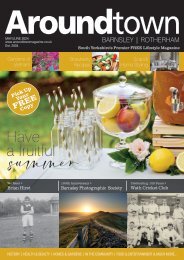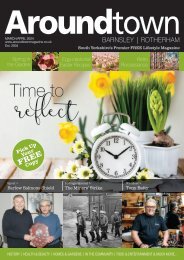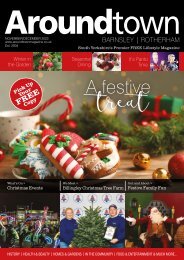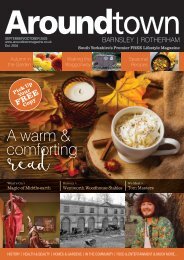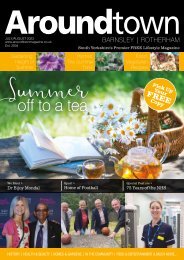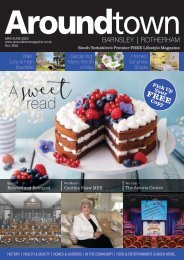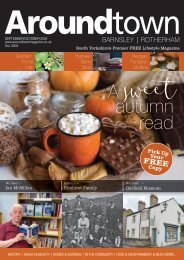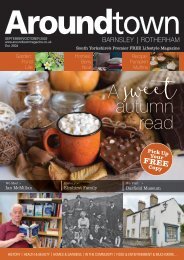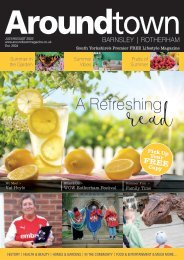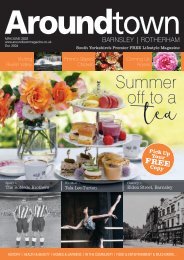Aroundtown Magazine Winter 2022 edition
Read South Yorkshire's premier lifestyle magazine.
Read South Yorkshire's premier lifestyle magazine.
You also want an ePaper? Increase the reach of your titles
YUMPU automatically turns print PDFs into web optimized ePapers that Google loves.
OUT & ABOUT<br />
Blue Tit<br />
Blue tits<br />
Blackbird<br />
The males live up to their name,<br />
but confusingly females are brown<br />
and often have spots or streaks on<br />
their breasts. The bright orangeyellow<br />
beak and eye-ring make adult<br />
male blackbirds one of the most<br />
striking garden birds. Its mellow song<br />
is also a favourite.<br />
Starling<br />
Smaller than blackbirds,<br />
with a short tail, pointed head<br />
and triangular wings, starlings<br />
look black at a distance but<br />
up-close they are very glossy<br />
and shimmer with purple and<br />
green. Their flight is fast and<br />
direct, and they walk and run<br />
confidently on the ground.<br />
They spend much of the<br />
year in flocks. A murmuration<br />
of starlings is an amazing<br />
sight – a swooping mass of<br />
thousands of birds whirling<br />
in the sky above. While still<br />
one of the most common<br />
garden birds, starlings’ decline<br />
elsewhere makes them a Red<br />
List species, meaning they’re<br />
critically endangered.<br />
Streaked with a colourful<br />
mix of blue, yellow, white and<br />
green, blue tits are one of our<br />
most attractive garden visitors.<br />
Blue tits happily take all kinds<br />
of bird food and are a vibrant<br />
addition to gardens across the<br />
country.<br />
Woodpigeon<br />
The largest and most common<br />
pigeon in the UK, the woodpigeon is<br />
largely grey with a white neck patch<br />
and white wing patches, clearly<br />
visible in flight. Although shy in the<br />
countryside, it can be tame and<br />
approachable in towns and cities.<br />
Its cooing call is a familiar sound in<br />
woodlands, as is the clatter of its<br />
wings when it flies away.<br />
Starling<br />
If you’re new to<br />
birdwatching,<br />
the RSPB also has<br />
some simple tips to<br />
get you started:<br />
Start off small:<br />
It can seem daunting with so<br />
many bird species to distinguish<br />
between, but garden birds<br />
are a great way to start your<br />
birdwatching adventure. They are<br />
some of the easiest to identify and<br />
tend to hang around long enough<br />
for you to take a quick snap to<br />
reference later if you need.<br />
Put up feeders:<br />
Not only will that make them stay<br />
for longer but if you feed them<br />
regularly birds learn that your<br />
garden is a great place to keep<br />
coming to. Different feeders and<br />
food will attract a variety of birds<br />
so feel free to experiment and<br />
see who comes to visit. You don’t<br />
necessarily need an all singing all<br />
dancing feeder – even a tray on a<br />
table will make a nice start.<br />
Best time to watch:<br />
Although birds are around at any<br />
time, you’ll also see more birds<br />
first thing in the morning –<br />
as they say, the early bird<br />
catches the worm!<br />
Thankfully, you don’t have to be<br />
an expert to tell a house sparrow<br />
from a goldfinch. The RSPB has a<br />
useful bird identification guide on<br />
hand to help.<br />
Robin<br />
Chaffinch<br />
For your free Big Garden<br />
Birdwatch guide,<br />
which includes a bird identification<br />
chart, top tips for your birdwatch,<br />
RSPB shop voucher, plus advice<br />
on how to help you attract wildlife<br />
to your garden, text BIRD to 70030<br />
or visit www.rspb.org.uk/<br />
birdwatch<br />
aroundtownmagazine.co.uk 33



